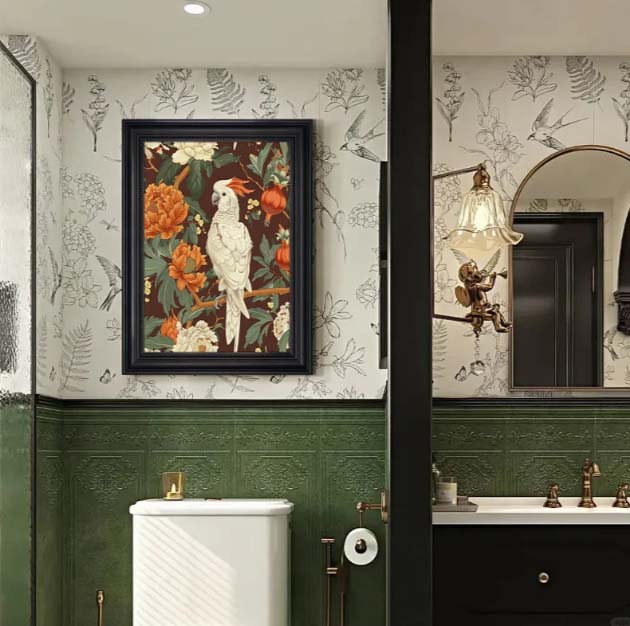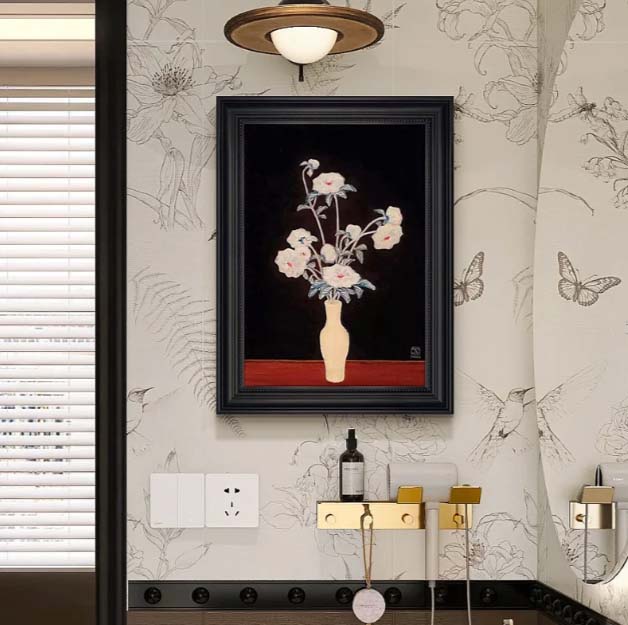This often humid, functional space demands careful consideration regarding materials, subject matter, and placement to ensure the art endures and enhances the room rather than deteriorates or clashes. This guide outlines the key factors for successfully hanging pictures in bathrooms and choosing what to hang on a bathroom wall, focusing on practical solutions like paintings for bathroom walls and canvas art in bathroom settings.
The primary factor influencing art selection is the bathroom's inherent humidity and temperature fluctuations. Steam from showers and baths creates a moist environment potentially damaging to many traditional art materials. Paper-based prints, watercolours, and unprotected photographs are highly susceptible to warping, mould, and fading. Furthermore, bathrooms are typically smaller spaces, demanding art that complements the scale without overwhelming it. Artwork here should ideally contribute to the desired atmosphere.

Given the humidity, prioritising moisture-resistant materials is paramount. Canvas art in bathroom settings can work well, but only if properly protected. Explore durable canvas options, like floral oil paintings on artphiloso. Look for canvases sealed with a high-quality, water-resistant varnish. Alternatively, consider canvas prints encapsulated in acrylic (often called "acrylic face mounts"), which creates a sealed barrier. Metal prints are an excellent choice, as aluminium is impervious to moisture and offers a sleek, modern finish. Acrylic prints (direct prints onto plexiglass) are another durable and contemporary option. High-quality, UV-protected Giclée prints on synthetic papers, also sealed under acrylic or glass, offer more image variety with good resilience. Avoid inexpensive paper posters, delicate watercolours, or unprotected photographs.

When deciding what to hang on a bathroom wall, consider themes that harmonise with the space. Nature-inspired subjects are perennial favourites: serene seascapes, lush botanicals (ferns, tropical leaves, florals), calming forest scenes, or abstract interpretations of water and stone. These motifs naturally complement the bathroom's function and can enhance a relaxing ambiance. Abstract art, particularly with fluid forms and watery blues, greens, or soft neutrals, works exceptionally well, avoiding literal interpretations that might feel out of place. Minimalist designs with clean lines and limited palettes suit modern bathrooms and smaller spaces effectively. For powder rooms or family bathrooms, don't shy away from humour, quirky illustrations, or bold graphic prints – these smaller spaces can handle more personality. Avoid overly dark or complex pieces that might feel oppressive in a confined area.

Hanging pictures in bathrooms requires attention to both aesthetics and practicality. Consider the wall space carefully. Above the toilet tank is a common spot, suitable for a single medium-sized piece or a small vertical grouping. Larger walls adjacent to the bath or opposite the vanity offer opportunities for statement pieces or curated groupings. Use the mirror to your advantage; art reflected can make the space feel larger. Crucially, avoid placing valuable or delicate artwork directly in the splash zone of the sink or shower. Ensure the hanging hardware is appropriate for the wall material (tile, drywall, plaster) and the artwork's weight. For heavier pieces, always secure into wall studs or use robust hollow-wall anchors specifically designed for the weight. A laser level is invaluable for achieving precise placement, especially for groupings.

Even with resilient materials, some care extends longevity. Ensure good bathroom ventilation – always use the extractor fan during and after showers to reduce overall humidity levels. Wipe down frames and the surface of glass or acrylic-covered pieces occasionally with a soft, slightly damp cloth to remove any soap scum or condensation residue, drying immediately. Avoid harsh chemical cleaners. Periodically check the back of canvases or paper-based pieces (if used behind glass) for any early signs of moisture ingress, though choosing the right materials upfront significantly reduces this risk.

Bathroom art transcends mere decoration. In this intimate space dedicated to daily rituals, a carefully chosen piece becomes a quiet companion. It transforms a purely functional moment into a small encounter with beauty, reflection, or unexpected delight. Whether it’s the serene flow of an abstract evoking water, the vibrant energy of a botanical print, or the subtle humour of a well-placed illustration, the right artwork elevates the mundane. It proves that thoughtful aesthetics belong everywhere, even here, enhancing our daily routines with moments of visual respite and personal expression.

The bathroom, often overlooked as a venue for art, presents a unique and surprisingly potent canvas for personal expression. It is a space of transition, privacy, and routine – where moments of quiet reflection occur amidst the steam. Placing art here is an act of elevating the everyday, a declaration that beauty and contemplation belong in all corners of our lives. The right piece transforms this functional room into a small sanctuary, a gallery for one, where a splash of colour, a captivating texture, or a resonant image can set the tone for the day or offer a moment of calm at its end. It’s a testament to art’s power to infuse meaning and pleasure into the most intimate and utilitarian spaces we inhabit.

About Artphiloso
Hi, I’m Philo, a Chinese artist passionate about blending traditional Asian art with contemporary expressions. Through Artphiloso, my artist website, I share my journey and creations—from figurative painting and figure painting to floral oil painting and painting on landscape. You'll also find ideas for home decorating with paint and more.

While possible, ensure it's a high-quality, gallery-wrapped canvas sealed with multiple coats of water-resistant varnish. Positioning it away from direct shower steam is crucial. Acrylic or metal prints are often more reliably durable.
Centre the artwork roughly 6-10 inches above the tank lid. Ensure it's not so high that it feels disconnected from the space below.
Use specialised tile hooks with adhesive pads designed for tiled surfaces, or drill carefully using a masonry bit and appropriate wall plugs/anchors, ensuring you avoid pipes. Adhesive hooks rated for the weight can work for lighter pieces.
Yes, if the frame is moisture-resistant (like sealed wood, metal, or plastic) and the backing is sealed. Ensure the glass is clean and tight within the frame. Avoid valuable original works on paper.
Yes, but use extreme caution. Heavy pieces must be anchored securely into wall studs using appropriate heavy-duty picture hooks or D-rings and wire. Always check the weight rating of your hardware and the wall's capacity.
